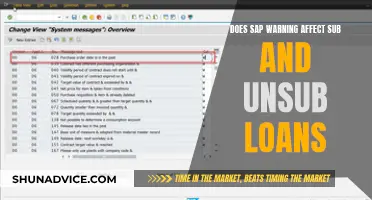
The Social Security System (SSS) in the Philippines offers a Calamity Loan Assistance Program to its members. This program provides financial assistance to those who have been affected by natural disasters such as typhoons and tropical cyclones. The loan amount is typically equivalent to one monthly salary, with a maximum of ₱20,000, and can be paid back in 24 monthly installments over two years. To qualify for the loan, members must reside in a declared calamity area and meet certain contribution requirements, such as having at least 36 monthly contributions. Applications can be submitted online through the My.SSS portal or offline at SSS Branch Offices.
What You'll Learn

Requirements for qualification
The Social Security System (SSS) in the Philippines offers a Calamity Loan Assistance Program to support members affected by natural disasters such as tropical cyclones, typhoons, and earthquakes. To qualify for this financial assistance, members must meet the following requirements:
- Residency in a declared calamity area: Applicants must be residents of areas officially declared as calamity-stricken by the National Disaster Risk Reduction and Management Council (NDRRMC). This typically includes areas affected by tropical cyclones, typhoons, or other extreme weather events.
- Property damage or loss: Applicants must have suffered damages or losses to their properties due to the calamity.
- Contribution history: Members must have at least 36 monthly contributions, with six of those contributions posted within the last 12 months before the month of filing the application.
- Current membership type: For individually paying members, such as self-employed, voluntary, and land-based Overseas Filipino Workers (OFWs), they must have at least six posted monthly contributions under their current membership type before applying for the loan.
- No outstanding loans or final benefit claims: Applicants should not have any past due SSS Short-Term Member Loans, restructured loans, or outstanding balances under the Loan Restructuring Program (LRP) or Calamity Loan Assistance Program (CLAP). They must also not have received any final benefit claims, such as permanent total disability or retirement benefits.
- Age limit: Applicants must be below 65 years of age at the time of loan application.
- Employer certification: For employed applicants, their employer must certify their loan application through the online My.SSS facility.
It is important to note that the SSS may have additional requirements or conditions for qualification, and members should refer to the official SSS website or contact their local SSS branch for the most up-to-date and accurate information.
Sofi's Loan Sales: What You Need to Know
You may want to see also

Application process
The Social Security System (SSS) in the Philippines offers a Calamity Loan Assistance Program to support members affected by natural disasters, such as typhoons and earthquakes. The program provides financial assistance to those who meet specific eligibility criteria and reside in areas declared as calamity-stricken by the National Disaster Risk Reduction and Management Council (NDRRMC).
- Register and Create an Account: If you don't already have a My.SSS account, visit the SSS Online Members Page and click "Register." Follow the instructions, provide basic information, and create your password by clicking on the activation link sent to your email.
- Login and Navigate to the Application: Once registered, log in to your My.SSS account. On your dashboard, click on "Services," then select "Disbursement Modules" and "Disbursement Account Enrollment Module."
- Enroll Your Bank Account: In the Disbursement Account Enrollment Module, nominate your valid bank account. This account will be used for disbursing the calamity loan proceeds if your application is approved.
- Apply for the Calamity Loan: Click on "Loans," then "Apply for Calamity Loan." Provide all the required information and click "Proceed." Review your application outline and submit it.
- Track Your Application: After submitting your application, regularly check your My.SSS inbox for notifications and updates regarding your loan application status.
- Offline Application: If you prefer a traditional application method, you can visit any SSS Branch Office and submit the required documents. If you are filing on behalf of another SSS member, ensure you have an authorization letter.
It is important to note that the SSS may have specific requirements and conditions for the Calamity Loan, such as contribution history, residency in a declared calamity area, and no outstanding loans or final benefit claims.
The loan amount offered is typically equivalent to one Monthly Salary Credit (MSC), calculated based on the average of the last twelve MSCs, or it can be up to a maximum of ₱20,000. The loan is payable within two years, with interest and penalties applicable in certain cases.
Loaning Young Players: Hindering or Helping Their Potential?
You may want to see also

Loan amount and repayment
The SSS Calamity Loan is a short-term member loan program for eligible members who reside in areas affected by natural disasters, such as typhoons and earthquakes, and have suffered losses or damages to their properties. The loan amount is equivalent to one Monthly Salary Credit (MSC), computed based on the average of the last twelve MSCs, rounded up to the nearest thousand, or up to a maximum of ₱20,000. The loan is payable within two years, in twenty-four equal monthly installments, starting on the second month following the date of loan approval.
For employed members, the loan is typically paid through salary deductions, while self-employed or voluntary members can make payments at SSS Branch Offices, SSS-accredited banks, or SSS-authorized payment centers. It is important to note that members with outstanding balances will have the arrearages and unpaid loan amounts, along with interest and penalties, deducted from their claimed benefits.
To apply for the SSS Calamity Loan, eligible members can submit their applications online through the My.SSS portal or via the SSS Online Members Page. Alternatively, applications can be submitted offline by visiting any SSS Branch Office and providing the necessary requirements. The deadline for submitting calamity loan applications is within three months of the SSS' announcement regarding the specific disaster.
It is worth mentioning that there are additional requirements for self-employed, voluntary, and land-based Overseas Filipino Workers (OFWs). These individuals must have six posted monthly contributions under their current coverage or membership type before the month of the calamity loan application. They must also ensure they have no outstanding balances in the SSS Loan Restructuring Program (LRP) or CLAP and have not availed of final benefits such as retirement or permanent total disability.
Square's Loan Services: What You Need to Know
You may want to see also

Interest rates and penalties
The SSS calamity loan is offered by the Republic of the Philippines Social Security System to members in areas that have been declared under a state of calamity due to natural disasters such as typhoons and earthquakes. The interest rate for the SSS calamity loan program is 10% per annum, computed on a diminishing principal balance. This interest is prorated from the date of loan granting until the end of the month prior to the first amortization month and is deducted in advance from the loan proceeds.
The SSS calamity loan is payable within two years in 24 equal monthly installments. The loan amortization starts on the second month following the date of the loan's approval. The payment deadline is on or before the last day of the month following the applicable month. In the case of a delay in payment for the month, a full month's penalty will be charged at a rate of 1% per month on unpaid principal and interest until fully paid.
If a member-borrower fails to immediately pay the outstanding balance, the unpaid loan, as well as the interest and penalty, shall be deducted from the benefits being claimed by the member. For employed members, this will be deducted from their final benefits (total disability/retirement/death). For self-employed/voluntary members, it will be deducted from their short-term benefits (sickness/maternity/partial disability) or final benefits (total disability/retirement/death).
It is important to note that an existing calamity loan must be fully paid before a member can avail of future calamity loans from SSS. Any overpayment on a previous loan will be subject to validation by SSS, and if valid, will be applied to the active loan. If there is no active loan, the overpayment will be refunded upon request. Cumulative unpaid obligations equivalent to more than six monthly amortizations will result in loan default. A defaulted account is subject to the same 10% interest per annum charged on the outstanding principal balance, with an additional 1% penalty per month until fully paid.
The SSS has announced plans to reduce the interest rate on its calamity loan programs by the end of 2025.
Understanding Boarder Income with Section 184 Loan
You may want to see also

Alternatives to the SSS calamity loan
The SSS Calamity Loan Assistance Program (CLAP) is a lending program offered to SSS members living in calamity-stricken areas. The loan amount is equivalent to one Monthly Salary Credit (MSC), which is computed based on the average of the last 12 MSCs, or up to ₱20,000. Members can pay back the loan in 24 equal monthly installments over two years, with a 10% annual interest rate.
- SSS Salary Loan: Tropical cyclone-affected members can avail of the SSS salary loan as an alternative. To qualify, applicants must be under 65 years of age and must not have received any final benefits, such as total disability, retirement, or death benefits. They must also have at least 36 monthly contributions to qualify for a loan of up to ₱20,000, or 72 monthly contributions for a loan of up to ₱40,000. Six of these contributions must have been made in the last 12 months before the loan application and must be under the current membership type.
- Three-Month Advance Pension: This is another program under the SSS's Calamity Assistance Program (CAP). It provides members with an advance on their pension for three months.
- Other Government-Provided Financial Assistance: Depending on the specific circumstances, there may be other financial assistance programs offered by the government or local authorities. These programs may include grants, subsidies, or low-interest loans to help individuals and businesses affected by natural disasters.
- Bank Loans: Members can also explore the option of applying for a loan through their bank. Some banks may offer special loan programs or financial relief measures during times of natural disasters. It is worth contacting your bank to discuss possible alternatives.
- Non-Governmental Organization (NGO) Assistance: In some cases, NGOs may provide financial assistance or grants to individuals affected by natural disasters. These organizations often have funds specifically allocated for disaster relief and community support.
- Personal Loans from Family or Friends: If all else fails, members can consider borrowing money from their personal network of family or friends. This option may provide more flexible repayment terms and potentially lower interest rates than formal loan programs.
It is important to carefully consider the terms and conditions, interest rates, and repayment options of each alternative before making a decision. Each option may have different eligibility requirements, and it is crucial to assess your own situation to determine which alternative best suits your needs.
Stafford Loans: Income or Not? Understanding Section 8 Rules
You may want to see also







